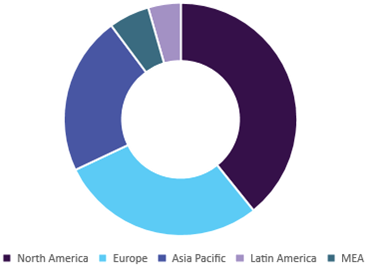Defibrillator Market Analysis: Increasing awareness and supportive government policies enhancing growth of the market
Defibrillation is a treatment for ventricular fibrillation and nonperfusion ventricular tachycardia. These episodes can cause Sudden Cardiac Arrest (SCA). Almost 50.0% of the cardiovascular deaths can be attributed to SCA.
Due to imbalance in the electrical system of the heart, the heart rhythm is affected, which leads to arrhythmias. This condition may lead to SCA. To correct this rhythm, an electrical impulse is sent to the heart in form of a shock, which results in depolarization of the heart and corrects arrhythmia.
Defibrillators are used in two ways in case of SCA: The first type of device is used for temporary purposes where arrhythmias are controlled until the patient reaches the hospital or medical help arrives, which are called External Defibrillator(ED), for example, manual ED and Automated ED (AEDs). These are used to monitor and prevent future episodes, while a more permanent treatment option is being delivered to the patient. These devices fall into the category of wearable defibrillators, which are worn by patients who are susceptible to SCA, but are on the waitlist for Implantable Cardioverter Defibrillators (ICDs).
The second type of device used is a more permanent treatment option for patients suffering from arrhythmias, or have higher chances of suffering from arrhythmias. These devices are called ICDs. These devices are commonly used along with drugs such as beta blockers or procainamide.
Defibrillator segments to focus on:
Public Access Defibrillators (PADs): The number of such devices is increasing continuously in the defibrillator market, due to growing awareness about the importance of defibrillation and how it can save lives.
The number of PADs increased due to extensive support from the government. The U.S. and the UK governments, for instance, are currently trying to enact a law that is anticipated to make PADs available at schools, sports arenas, institutes, and offices. This is most likely to drastically increase demand for AEDs.
Hospitals: The variety and number of defibrillators used in hospitals contribute to about 80.0% of the overall defibrillator market. This is due to the wide use of implantable and external defibrillators in this segment.
The growth of ICDs in this segment may increase steadily in the coming years, as the burden of noncommunicable diseases, such as cardiovascular diseases, increases, which is expected to fuel growth of the defibrillator market.
Defibrillator market, 2016 (USD Million)

The future of PADs
In 2004, a law implemented in Japan allowed people to use AEDs without training. Postimplementation, the volume of AEDs in Japan increased exponentially. A total number of 45,000 AEDs were sold in Japan in 2006, which made it the second largest market for defibrillators after the U.S. AEDs were then made available in densely populated areas through vending machines. In April 2007, 130 of such vending machines were operational. Public access to AEDs in Japan increased by 40 folds between 2005 & 2013 and was documented to be 428,821 in 2013 by Ryan Flanagan on NOW @ NEJM-a blog for physicians.
The government also introduced an innovative way to make these vending machines cost-effective. These vending machines were used to display advertisements, negating the cost the government incurred in placement of defibrillators. This also drastically decreased deaths from SCA.
The exponential increase in the number of defibrillators may be attributed to the change in the legislation, making it a prime example of increased demand for defibrillators.
 In-depth report on global defibrillator market by Grand View Research:
In-depth report on global defibrillator market by Grand View Research:
https://www.grandviewresearch.com/industry-analysis/defibrillators-market
To schedule a free market intelligence database demo, please complete the form below:
Service Guarantee
-
Insured Buying
This report has a service guarantee. We stand by our report quality.
-
Confidentiality
Your transaction & personal information is safe and secure.
-
Custom research service
Design an exclusive study to serve your research needs.
-
24/5 Research support
Get your queries resolved from an industry expert.